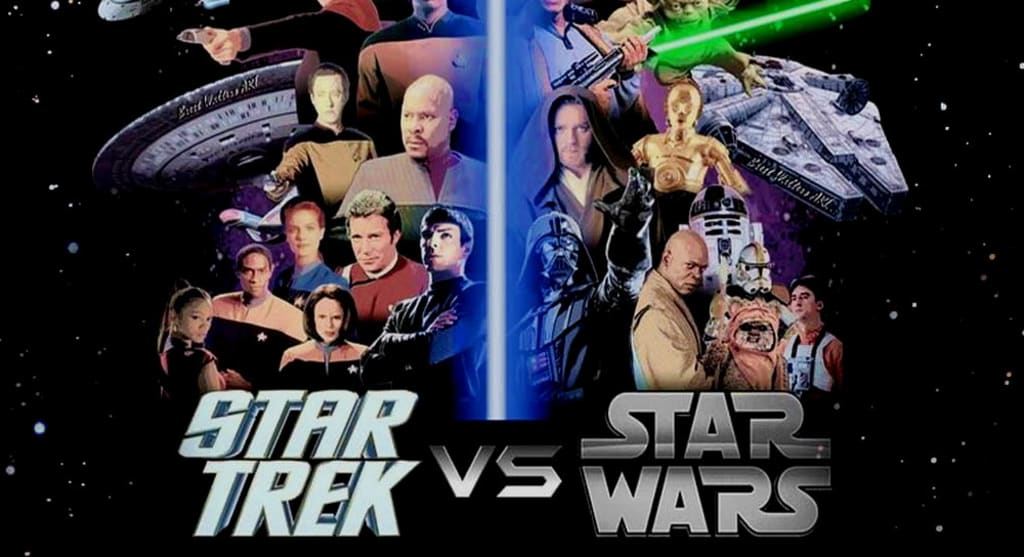

Star Trek vs. Star Wars: A Celebration of Two Sci-Fi Titans
For decades, Star Trek and Star Wars have stood as pillars of science fiction and fantasy storytelling, each with its own distinct identity, philosophy, and fanbase. Though often pitted against one another in a rivalry fueled by comparisons, these franchises have much more in common than their fans sometimes realize. Both celebrate imagination, storytelling, and community, offering lessons not only in the value of diversity but also in how shared passions can unite us. In this article, we’ll not only explore the histories, themes, and cultural impacts of Star Trek and Star Wars but also examine the bridge between the science of Star Trek and the spirituality of Star Wars—a nexus where discovery, adventure, and a profound sense of wonder converge.
The Origins of Star Trek: Boldly Going Where No Show Had Gone Before
Star Trek’s debut in 1966 marked a seismic shift in science fiction storytelling. Created by Gene Roddenberry, the series imagined a future where humanity had transcended war, poverty, and prejudice to explore the stars united under the Federation. While other shows of the era focused on interpersonal drama or episodic thrills, Star Trek dared to ask complex questions about morality, identity, and the price of progress. The voyages of the USS Enterprise weren’t just thrilling; they were thoughtful, asking viewers to wrestle with questions that echoed real-world issues—from Cold War tensions to civil rights struggles.
The diversity of Star Trek’s original cast was radical for the time. Lieutenant Uhura, portrayed by Nichelle Nichols, was not only a capable officer but also a symbol of hope and representation for countless fans. Nichols’ choice to remain on the show after a pivotal conversation with Martin Luther King Jr. underscores the cultural weight Star Trek carried even in its early days. Spock’s logical Vulcan philosophy, Kirk’s daring leadership, and McCoy’s humanistic compassion created a dynamic triad, representing a balance of intellect, action, and emotion—a precursor to the way Star Trek balances science, exploration, and humanity.
The Arrival of Star Wars: A Galaxy Far, Far Away
Star Wars, released in 1977, didn’t just introduce audiences to a galaxy of lightsabers and starships—it created a new mythology for the modern age. George Lucas masterfully blended influences ranging from Joseph Campbell’s “monomyth” theory to Akira Kurosawa’s samurai films, resulting in a cinematic universe that felt ancient and futuristic all at once. Where Star Trek pondered the future of humanity, Star Wars reached into the past, invoking timeless themes of destiny, faith, and the eternal struggle between good and evil.
The original trilogy’s success owes much to its characters. Luke Skywalker, an everyman hero with a thirst for adventure, embodied hope and the potential for self-discovery. Princess Leia defied the damsel-in-distress trope, leading rebellions with grace and grit. And then there was Darth Vader—a tragic villain whose journey from darkness to redemption remains one of cinema’s most iconic arcs. Star Wars didn’t just create heroes; it created archetypes that resonated across cultures.
Science and Spirituality: The Nexus of Star Trek and Star Wars
While often viewed as opposites—Star Trek with its commitment to science and logic, Star Wars with its embrace of mysticism—both franchises explore a profound truth: the quest for understanding and meaning in the universe. Star Trek champions the scientific method, showing how technology and collaboration can overcome obstacles and bring people together. Its starships and tricorders are symbols of humanity’s ingenuity and determination to understand the cosmos.
Yet even in Star Trek, there are moments that touch on the spiritual and mysterious. The Q Continuum, a race of omnipotent beings, challenges the crew to confront existential questions about power, morality, and humanity’s place in the universe. The Bajoran Prophets in Deep Space Nine blend religious faith with interdimensional science, showing that the line between spiritual belief and advanced understanding can blur.
Star Wars, meanwhile, grounds its mysticism in the Force, a metaphysical energy that binds the galaxy together. The Force is not limited to Jedi and Sith; it’s a reminder that everyone is connected by something greater than themselves. While it may seem mystical, the Force reflects a universal human desire to seek connection and purpose. Jedi teachings about balance and mindfulness echo philosophical and even scientific principles about energy and equilibrium.
In both franchises, exploration is the ultimate goal. Whether it’s the crew of the Enterprise seeking out new life and new civilizations or Luke Skywalker looking beyond the horizon on Tatooine, Star Trek and Star Wars remind us that discovery—be it scientific, personal, or spiritual—is at the heart of the human experience. Science and spirituality, rather than being oppositional, converge as forces that drive us to look beyond what we know.
Cultural Impact: Shaping Generations of Dreamers
Star Trek’s influence on technology and society cannot be overstated. Its vision of a united Earth inspired scientists and engineers to turn fiction into reality. Martin Cooper, the inventor of the mobile phone, credited Star Trek’s communicators as an inspiration. NASA named its first space shuttle Enterprise, honoring the series’ legacy of inspiring space exploration.
Star Wars, on the other hand, revolutionized storytelling and the film industry. Its use of special effects, sound design, and merchandising set the standard for modern blockbusters. But its impact goes beyond the silver screen. The saga’s exploration of family, identity, and redemption has resonated deeply with audiences, making it a source of comfort and inspiration for generations. Its influence is seen not only in movies but also in fan art, music, and countless other creative expressions.
Fandom as a Bridge Between Worlds
Both Star Trek and Star Wars have fostered passionate, creative communities. Star Trek’s conventions were among the first to bring fans together in celebration of their shared love for a franchise. These gatherings became spaces for cosplay, fanfiction, and discussions that often explored social and political issues mirrored in the show.
Star Wars fandom brought similar energy, with events like Star Wars Celebration drawing fans from across the globe. The sheer breadth of creative output from Star Wars fans—from detailed fan films to original novels—highlights the saga’s enduring ability to inspire. Cosplay, in particular, serves as a bridge between these universes. Whether it’s a Trekker donning a Starfleet uniform or a Star Wars fan perfecting their Mandalorian armor, the shared love of craftsmanship and storytelling unites fans from both galaxies.
Why Both Fandoms Should Unite
At their core, Star Trek and Star Wars share common values: hope, exploration, and the belief that individuals can make a difference. Star Trek’s vision of a better future complements Star Wars’ message of personal growth and resilience. Together, they present a holistic view of humanity’s potential—balancing the tangible achievements of science with the intangible power of belief and connection.
By embracing these shared values, fans can move beyond rivalry to celebrate the strengths of both franchises. Imagine a crossover where Spock and Yoda debate the nature of logic and the Force, or a collaboration between the Rebel Alliance and Starfleet to face a common enemy. Such scenarios not only fuel creative thought but also underscore the universal themes that make both franchises timeless.
A Shared Future
Star Trek and Star Wars are more than entertainment—they are cultural touchstones that challenge us to dream bigger, think deeper, and connect more profoundly. Whether you’re navigating warp speed or wielding a lightsaber, the journeys these stories take us on remind us of the boundless possibilities of the human spirit. By embracing the science of exploration and the spirituality of connection, we can honor both legacies and chart a future where the stars are not the limit but the beginning of endless discovery.
